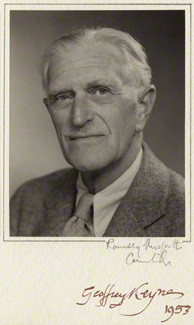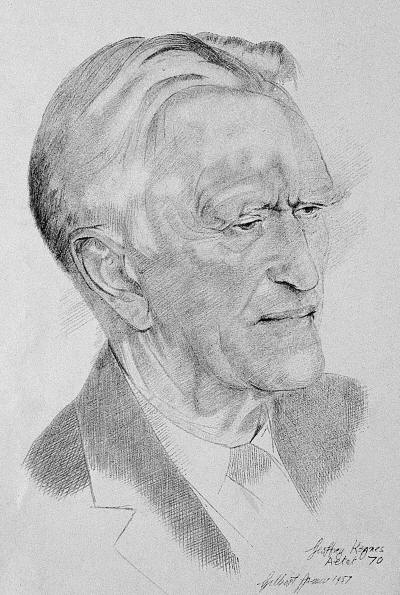

Queer Places:
Rugby School, Lawrence Sheriff St, Rugby CV22 5EH
University of Cambridge, 4 Mill Ln, Cambridge CB2 1RZ
St. Mary's Churchyard
Brinkley, East Cambridgeshire District, Cambridgeshire, England
 Sir
Geoffrey Langdon Keynes (25 March 1887, Cambridge
– 5 July 1982,
Cambridge)
was an English surgeon and author.[2]
In his youth, he had been a member of the circle of handsome (and sometimes
homosexual) young men who congregated at
Charles Edward Sayle's
house in Cambridge, including
Rupert Brooke,
George Mallory
and
Theo Bartholomew, who remained a close friend throughout his life.
Bartholomew's collection of Sassoon's works, and some of his manuscripts, is
now at Cambridge University Library in the collection of Geoffrey Keynes.
Henry Festing Jones edited
Samuel Butler's works with Theo Bartholomew.[16]
On Bartholomew's death in 1933, Geoffrey
Keynes became Jones' literary executor,
taking on also the papers of Jones and Butler, acting with Brian Hill.[17][18]
Sir
Geoffrey Langdon Keynes (25 March 1887, Cambridge
– 5 July 1982,
Cambridge)
was an English surgeon and author.[2]
In his youth, he had been a member of the circle of handsome (and sometimes
homosexual) young men who congregated at
Charles Edward Sayle's
house in Cambridge, including
Rupert Brooke,
George Mallory
and
Theo Bartholomew, who remained a close friend throughout his life.
Bartholomew's collection of Sassoon's works, and some of his manuscripts, is
now at Cambridge University Library in the collection of Geoffrey Keynes.
Henry Festing Jones edited
Samuel Butler's works with Theo Bartholomew.[16]
On Bartholomew's death in 1933, Geoffrey
Keynes became Jones' literary executor,
taking on also the papers of Jones and Butler, acting with Brian Hill.[17][18]
Keynes began his career as a physician in World War I, before becoming a doctor at St Bartholomew's Hospital in London, where he made notable innovations in the fields of blood transfusion and breast cancer surgery. Keynes was also a publishing scholar and bibliographer of English literature and English medical history, focusing primarily on William Blake and William Harvey.

Geoffrey Keynes was born on 25 March 1887 in Cambridge, England.[3] His father was John Neville Keynes, an economics lecturer at the University of Cambridge and his mother was Florence Ada Brown, a successful author and a social reformer.[3] Geoffrey Keynes was the third child, after his older brother, the prominent economist John Maynard Keynes, and his sister Margaret, who married the Nobel Prize–winning physiologist Archibald Hill.
He was educated at Rugby School, where he became friends with English poet Rupert Brooke.[4] In 1915 he was appointed literary executor for Brooke's estate.
He graduated from Pembroke College, Cambridge, where he earned a first-class degree in the Natural Sciences Tripos.[5] He was later made an honorary fellow of Pembroke College.[6] Keynes then qualified for a scholarship to become a surgeon with the Royal College of Surgeons in London.[3]
Keynes delayed his medical education in order to serve in World War I, where he served as a Lieutenant in the Royal Army Medical Corps and then worked as a consultant surgeon, becoming an expert in blood transfusion.[3] His experience in the First World War led him to publish Blood Transfusion, the first book on the subject written by a British author.[6] Keynes also founded the London Blood Transfusion Service with P. L. Oliver.[5] Alexander Bogdanov acquired a copy of this book whilst visiting London to negotiate the Anglo-Soviet Trade Agreement in 1922. Bogdanov went on to found the Institute for Haemotology and Blood Transfusions in Moscow.[7]
Keynes was deeply affected by the brutality and gore that he witnessed in the field, which may have influenced his dislike for radical surgery later in his career.
Keynes enlisted to be a consulting surgeon to the Royal Air Force at the outbreak of World War II. In 1944 he was promoted to the rank of acting air vice-marshal.[8]
Keynes began working full-time at St Bartholomew's Hospital in London, where he worked under George Gask and Sir Thomas Dunhill, after returning from World War I.[9] Keynes used his influence as an assistant surgeon to advocate for limited surgery instead of the invasive radical mastectomy. Frustrated with the mortality rate and gruesomeness of the radical mastectomy, Keynes experimented by inserting 50 milligrams of radium in a patient's tumour.[10] He later observed that, "The ulcer rapidly healed ... and the whole mass became smaller, softer and less fixed."[11]
Keynes pursued his new idea through a number of trials, observing the effectiveness of injecting radium chloride into breast cancer tumours compared with the effectiveness of the radical mastectomy.[12] The promising results of these trials led Keynes to be cautiously optimistic, writing in 1927 that the "extension of [an] operation beyond a local removal might sometimes be unnecessary."[11] Keynes' outlook was considered a radical break from the medical consensus at the time. Keynes wrote in his autobiography that his work with radium "was regarded with some interest by American surgeons," but that the concept of a limited mastectomy failed to gain significant traction in the medical community at the time.[10][13] His doubts regarding the radical mastectomy were vindicated some 50 years later, when innovators like Bernard Fisher and others revisited his data and pursued what became known as a lumpectomy.[10] Limited surgeries, like the lumpectomy, accompanied by radiation are now the standard treatment for breast cancer.[10]
Keynes was also a pioneer in the treatment of myasthenia gravis.[14] Much like with breast cancer, the medical community knew little about how to treat the disease at the time. Keynes pioneered the removal of the thymus gland, which is now the standard treatment for myasthenia gravis.[14]
In 1955 Keynes received a knighthood for services to medicine.[15]
Keynes maintained a passionate interest in English literature all his life and devoted a large amount of his time to literary scholarship and the science of bibliography. He was a leading authority on the literary and artistic work of William Blake.[4] He also produced biographies and bibliographies of English writers such as Sir Thomas Browne, John Evelyn, Siegfried Sassoon, John Donne and Jane Austen. He was also a pioneer in the history of science, with studies of John Ray, William Harvey and Robert Hooke.[14] His biography The Life of William Harvey was awarded the 1966 James Tait Black Memorial Prize. Keynes also collected books, with a personal library with around four thousand works.[4]
His autobiography The Gates of Memory was published in 1981, and he died the following year, aged 95. The Gates of Memory includes anecdotes of Keynes' numerous run-ins and friendships with other famous public figures. For example, Keynes often went climbing with George Mallory, the renowned British mountaineer; he also once performed life-saving treatment on Virginia Woolf after the budding author overdosed on pills.[15][13]
On 12 May 1917 Keynes married Margaret Elizabeth Darwin, the daughter of Sir George Howard Darwin and granddaughter of Charles Darwin. They had one daughter and four sons:
Keynes dedicated his life to his work and was also sociable with many friends. He took pride in never having been drunk, and was known by most as an affable, well-mannered man.[2]
Keynes' contributions profoundly influenced the fields of surgery and English literature. He pioneered limited breast cancer surgery accompanied by radiation, a strategy that has endured the test of time. His work on William Blake "was instrumental in establishing Blake as a central figure in the history of English art and literature."[6]
A library of his scholarly works, notes, and correspondences is held by the University of Cambridge.[8]
My published books: